NSDAP Gauleitung Visor Cap M39
CATEGORY: Version
SKU: 30.GOR.01.01.02.002.000
Estimated market value:
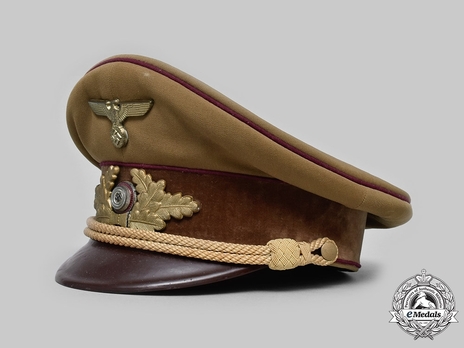
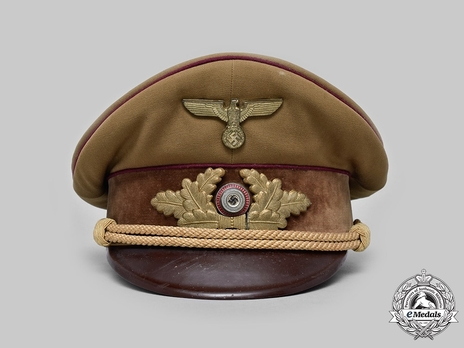
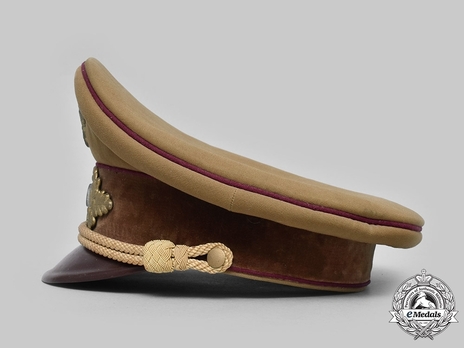
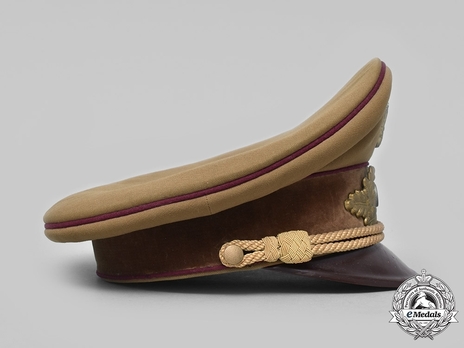
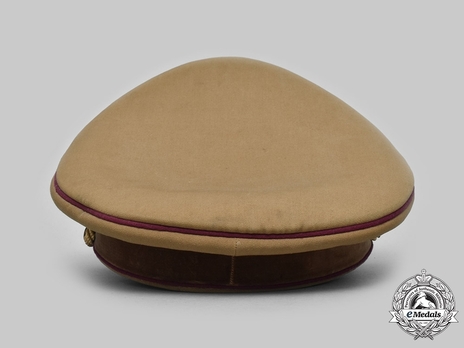
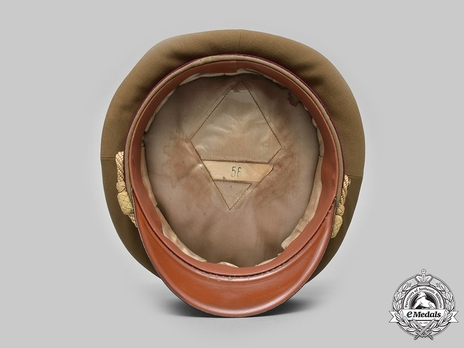
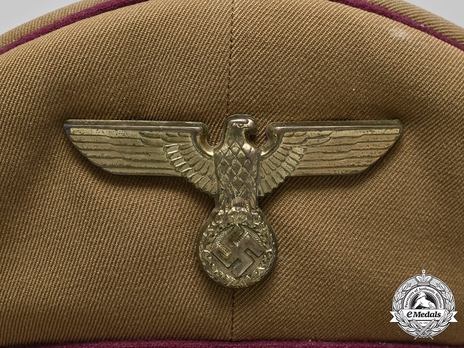
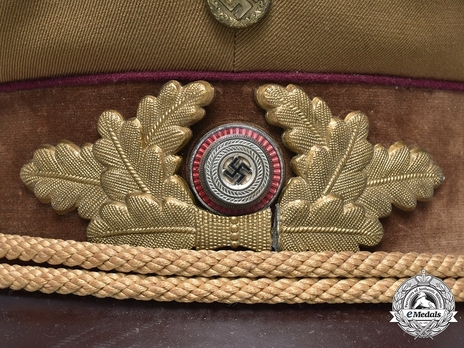
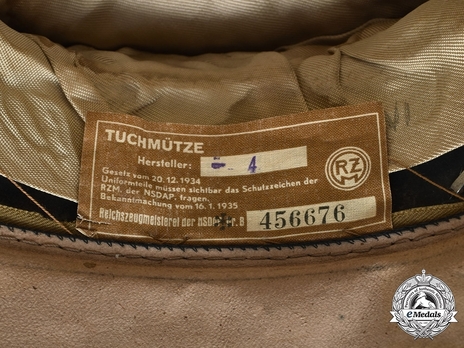
Estimated market value:
Constructed of smooth light brown wool. It features reinforced side walls, with the exterior of the walls bearing a smooth brown doeskin cap band. Bands of Burgundy-red piping adorn both the top and bottom of the cap band, as well as the circumference of the crown, indicating Gau level personnel. Pinned into the peak of the cap is an insignia in the form of a gilded aluminum alloy NSDAP-style German national eagle clutching a wreathed mobile swastika. The eagle measures 65 mm (w) x 33 mm (h), and retains its three reverse attachment prongs and almost all of its original gilt finish. Pinned into the cap band underneath the eagle is a cockade and wreath, with the former consisting of a red enameled medallion within gilded bronze frame, bearing a raised and ribbed medallion with a central black mobile swastika. The latter consists of a gilded bronze oak leaf wreath, with the insignia measuring 105 mm (w) x 45 mm (h). The cap is flanked on each side by a gilded and pebbled magnetic metal button, securing in place a decorative chinstrap constructed of fine gold bullion wire, resting upon the protruding visor. The latter is constructed of vulcanfibre and presents with a dark brown matte finish on the obverse. The interior of the cap features a brown leather sweatband 40 mm in width, securely held in place by a row of machine stitching. A padded silver-grey rayon liner fully encompasses the interior, with a transparent plastic rhomboid moisture guard stitched onto the crown. A paper inset with a black ink size mark of “56” is inserted into the moisture guard. The underside of the sweatband reveals an intact Reichszeugmeisterei (RZM) label bearing a secondary code of “456676”, as well as an illegible manufacturer’s code. The cap measures 245 mm (w) x 255 mm (l) x 160 mm (h). Small mothing holes are evident to the wool near the seams of the cap band, there is some soiling of the interior liner, and the wreath. The cap is in an overall near extremely fine condition.
The uniforms, headgear, and insignia of the National Socialist German Workers’ Party (Nationalsozialistische Deutsche Arbeiterpartei or NSDAP) went through several design changes from 1933 until the end of the Second World War. Dr. Ley, originally the Gauleiter of Rheinland and later promoted to the position of chief of staff of Party Organization and Reich Organization Leader, was largely responsible for the NSDAP rank system and uniforms.
The standardized production and circulation of all NSDAP uniform garments, headgear, and insignia were overseen by the National Material Control Office (RZM or Reichszeugmeisterei). The RZM was created in July 1934, and it was located in Munich. From 1935 onward, all NSDAP uniform garments and insignia were legally required to feature an RZM control mark or tag, as well as a number mark on metal insignia or belt buckles. These marks indicate the authenticity of the object, the type of insignia or garment, and identify the manufacturer.
The first attempt to standardize the NSDAP headgear began in 1933. The visor caps worn by NSDAP members underwent several iterations from 1933 until the end of the Second World War.
All versions of the cap were produced from a brown coloured material, with a brown velvet or velveteen cap band.
The first formalized version of the visor cap replaced the informal NSDAP Kepi style cap. It was officially introduced on January 20, 1934, hence it is being referred to as M(odel) 34. It can be found in the stiffer so-called "saucer" form (Tellermütze), which uses an internal wire to keep the shape of the cap, or the more relaxed so-called "old style" form (Klappmütze), which does not feature an internal wire and is therefore foldable.
Buttons and chin cords are either gold-coloured or silver-coloured, depending on the wearer's rank and position. However, gold-coloured chin cords were usually accompanied by gold-coloured buttons, and silver-coloured chin cords by silver-coloured buttons.
This cap features a small, silver-coloured national emblem eagle above the cap band and along the front seam, as well as the national tricolour cockade in the centre of the cap band. The visor of the M34 is generally produced from dark brown leather (sometimes black, but this was against regulations).
Piping was worn along the crown and above and below the cap band to identify the wearer’s political rank level. Piping colours include yellow for Reichsleitung level (national), red for Gauleitung level (larger district (Gau) level), black for Kreisleitung (district level), and light blue for Ortsgruppenleitung (local level).
Small changes were made constantly, but in 1939, a new design of the visor cap was introduced, known as the M39 cap.
The piping colours for the M39 were specified as golden-yellow for Reichsleitung level, dark red for Gauleitung level, white for Kreisleitung level, and light blue for Ortsgruppenleitung level.
Chin cords and buttons were gold-coloured for every rank. So was the national eagle emblem insignia. The tricolour cockade was now framed by an oak leaf wreath insignia.
Lastly, a cap with a white top for summer wear was introduced. The summer cap did not feature piping on the crown, only above and below the cap band.

Comments
Sign in to comment and reply.


Scroll Top